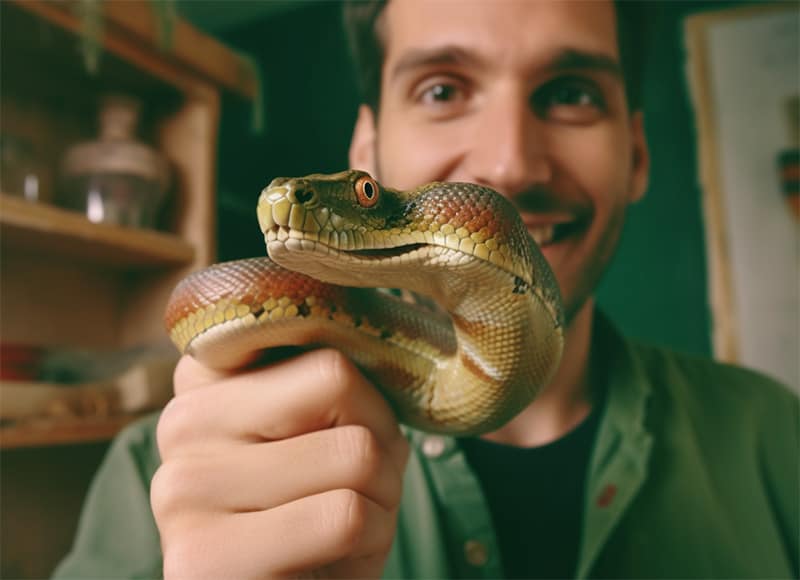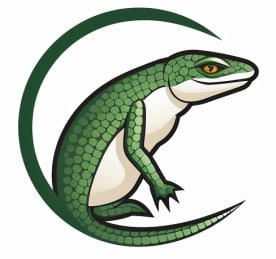Mexican Black Kingsnake Overview
The Mexican Black Kingsnake stands out with its striking, robust black scales. At around 3-4 feet in length, these non-venomous constrictors are relatively easy to care for and popular among snake enthusiasts. They prefer arid regions with high temperatures and low humidity.
As a pet, they need a basking spot, a hide box, and a water dish to recreate their natural environment. Temperature and humidity levels should be kept in check for them to remain healthy. These snakes are excellent feeders, but are prone to obesity if overfed. Rodents are their preferred food, but they should be appropriately sized for the size of the animal.
Uniquely, their skin reflects metallic shades when exposed to natural or artificial light. They have a mild temperament, but handling while they are shedding may cause them to become agitated. Mexican Black Kingsnakes are popular display pets, bred in captivity and recommended to beginners looking for an attractive, easy to maintain snake.
Little research has been done on their habitat preferences and habits outside of Mexico, where they have a limited distribution. Give your Mexican Black Kingsnake a luxurious home that any hotel would be jealous of!
Setting up the Enclosure
To set up the enclosure for your Mexican black kingsnake, you need to consider various factors such as enclosure size and substrate selection. Choosing the right size enclosure and selecting the right substrate play crucial roles in ensuring your snake’s comfort and overall health. We will discuss both sub-sections in detail to provide you with the necessary husbandry tips to create the ideal environment for your Mexican black kingsnake.
Choosing the Right Size Enclosure
Picking the right size enclosure for your pet is essential. Think about their size, how active they are, and if they may grow. A too small enclosure can cause stress and health issues. Here’s a guide to sizes for some popular pets.
| Animal | Minimum Enclosure Size |
|---|---|
| Rabbit | 12 square feet |
| Hamster | 360 square inches |
| Snake | Length of snake + 50% |
Keep in mind that these are minimum recommended sizes. Offering more space is always beneficial. Your enclosure should have enough space for a substrate depth, hiding spots, and accessories like food dishes or water bowls.
Pro-tip: Invest in a larger enclosure than recommended. That way, your pet can be comfy and happy. For the right substrate, think of it like buying a mattress. It could make the difference between a good night’s sleep and a sore back.
Substrate Selection
Choosing the Best Ground Cover:
Picking the right ground cover for your reptile species is essential for its overall wellbeing and behavior. Think about factors such as humidity, sanitation, insulation, and looks when deciding. The table below shows what substrate is best for each reptile.
| Reptile | Suitable Substrate |
|---|---|
| Leopard Gecko | Sand, Tile, Paper Towels |
| Bearded Dragon | Newspaper, Play Sand, Bark Chips |
| Corn Snake | Aspen Shavings |
| Ball Python | Cypress Mulch |
It’s important to keep track of your reptile’s activity and diet when selecting the substrate type. Too sandy or gritty substrates can cause digestive problems and impaction in some species.
In a study by Harms et al., they linked improper substrate use with an increase in respiratory infections in captive snakes.
If you want your pet to feel special, make sure their enclosure has the perfect lighting and temperature – no paparazzi required.
Temperature and Lighting
To ensure your Mexican Black Kingsnake stays healthy and comfortable, it’s important to regulate the temperature and lighting in their environment. Maintaining proper temperature control and a suitable lighting setup are crucial for your snake’s well-being. In this part, we’ll take a closer look at these two sub-sections and provide you with the necessary husbandry tips to ensure the best possible conditions for your pet.
Temperature Control
Controlling the temperature in your home is essential to achieve ideal living conditions. This range depends on several factors such as age, activity level and the outdoor weather. Check out the table below for guidance on the ideal temperature for each activity level:
| Activity Level | Ideal Temperature Range |
|---|---|
| Sedentary | 68-72°F |
| Light Activity | 65-68°F |
| Moderate | 60-65°F |
Remember, it’s more cost-effective to keep your house warmer in summer and colder in winter. Plus, thermal curtains can help regulate the indoor temperature and cut down heating/cooling costs. And don’t forget the power of good lighting, like a strategically placed candle – it can make a Tinder date go from disaster to delightful!
Lighting Setup
Lighting configuration is key when it comes to an optimal work environment. Here’s a look at the figures:
| Number of Lights | Color Temperature | |
|---|---|---|
| Overhead | 3 | 6500K |
| Desk lamp | 1 | 5000K |
Apart from these, there are also other lighting solutions available. Installing natural light-emitting diodes or circadian lighting systems can increase productivity and reduce eye strain.
Make sure you have all the right elements for an ideal workspace. Don’t miss out on unique perks of new technology or high-quality work standards.
Feeding and Watering Schedule
To maintain the health and well-being of your Mexican Black Kingsnake, it is crucial to follow a proper feeding and watering schedule. In order to achieve this, you need to equip yourself with some essential tips and techniques. This section will elaborate on the sub-sections, namely feeding tips, watering schedule, and techniques, that will help you provide the best care for your beloved pet.
Feeding Tips
Pet owners: it’s important to feed your pets right! Here are tips:
- Estimate portion size based on age, weight, breed & activity level.
- Divide daily food requirement into two or three meals.
- Avoid table scraps or human food, as it can cause health issues.
- Choose food with protein as main ingredient – wet or dry.
- Provide fresh water in a clean bowl, and change regularly.
- Monitor eating habits; consult vet if any concerns.
- Consider any dietary restrictions or allergies.
- Dispose of uneaten food properly to avoid pests.
Be careful when changing pet’s diet – once I bought different cat food and it caused an upset stomach & expensive vet visit! Double-check before switching. Dry plants need water to grow – same with pets and their diet!
Watering Schedule and Techniques
Properly Hydrating Your Plants!
Want to ensure your plants stay healthy and grow? Here’s how:
- Water in the Morning – Before the sun gets too hot. Give your plants enough moisture for the day!
- Water Deeply & Thoroughly – Get water to the root zone of your plant.
- Use the Right Techniques – Don’t wet the foliage – use a drip irrigation system or a soaker hose.
- Adjust Frequency – Check every fifteen days if soil two inches down is dry. Rainfall also affects how much you should water.
- Use Quality Water – Tap water is usually fine. But in drought/heatwave, use rainwater or greywater.
Hydrate smarter! Apply these techniques & watch visible changes soon. Keep your plants healthy & flourishing for years! Start learning plant hydration alternatives for better plants & environment. #FOMO
Health and Common Concerns
To ensure the health of your Mexican Black Kingsnake, it is important to be knowledgeable about possible health concerns. For effective care, this section on “Health and Common Concerns” with “Preventative Care” and “Common Health Issues” serves as a solution. Knowing and applying these tips can prevent potential health issues and provide the best care for your snake.
Preventative Care
Being proactive with health is a must. Preventive care involves check-ups, disease screenings, and vaccinations. These help detect and stop potential problems early. Good habits like exercising and eating right can reduce the chance of getting chronic illnesses. Moreover, preventive care also benefits mental health.
Though preventive healthcare can prevent future issues, treatment may still be needed. Talk to a healthcare provider to find the right care at the right time. The Centers for Disease Control and Prevention (CDC) says preventive care can add up to 10 years to your life. So why rely on WebMD when a doctor can tell you if your headache is just a cold or something more serious?
Common Health Issues
Common Health Concerns are a wide range of ailments that affect people worldwide. These can vary from minor to severe, physical or mental, chronic or temporary. Some examples include respiratory infections, allergies, skin conditions, digestive problems, obesity, stress and anxiety disorders, and sleep-related issues.
It is essential to get medical attention if symptoms persist. Early intervention can reduce complications.
Good nutrition, exercise, vaccinations, and sufficient rest are preventive measures to help manage common health concerns. Regular check-ups with a doctor or specialist can be beneficial for detecting underlying conditions.
Furthermore, digital eye strain caused by long screen time has been increasingly reported in adults and children. A University of Alabama at Birmingham study suggests long-screen time may cause irreversible damage to retinal cells.
To reduce digital eye strain risk, the study recommends people use devices with reduced blue light emissions or appropriate filters.
Safety comes first – except when playing Jenga with chainsaws – then it’s every man for himself!
Handling Tips and Safety Precautions
Dealing and Security Steps:
Manage the Mexican Black Kingsnake cautiously to evade any harm to both the snake and you. These are speedy serpents that can become jumpy if they sense threatened. Here are some tips for managing them securely:
- Clean your hands before and after managing
- Move toward them peacefully and constantly
- Lift them up delicately with both hands at the rear of their heads
- Steer clear of abrupt motions or deafening noises around them as it can frighten them
- Never manage them by the tail as it may cause injury to their spine
- Do not try to manage an unwell or hostile snake. Look for professional assistance instead.
Additionally, if you have other pets, make sure they are kept away from the snake during handling meetings.
Pro Tip: Put on gloves while managing the Mexican Black Kingsnake to bring down chances of bites or cuts.
Frequently Asked Questions
What is a Mexican Black Kingsnake?
A Mexican Black Kingsnake is a non-venomous snake species native to Mexico that can grow up to 5 feet long. It has a shiny black body with white or yellow stripes or bands.
What kind of habitat do Mexican Black Kingsnakes need?
Mexican Black Kingsnakes need a warm and dry habitat, such as a terrarium with a heat source and substrate that can retain moisture. They also need hides, branches, and rocks to climb on and hide behind.
What do Mexican Black Kingsnakes eat?
Mexican Black Kingsnakes are carnivores that eat mice, rats, and other small animals. They should be fed once a week and their prey should be appropriately sized for their body size.
How often do Mexican Black Kingsnakes shed?
Mexican Black Kingsnakes shed their skin every 4 to 8 weeks, depending on their age and growth rate. During shedding, they may become less active and refuse to eat.
What are some common health issues for Mexican Black Kingsnakes?
Some common health issues for Mexican Black Kingsnakes include respiratory infections, mites or ticks, and parasitic infections. It is important to regularly clean their habitat and take them to a veterinarian for check-ups.
Can Mexican Black Kingsnakes be handled?
Mexican Black Kingsnakes can be handled, but they may become stressed or bite if they feel threatened. It is important to handle them gently and infrequently to avoid causing stress.

Alex Hartford, the founder of Reptile Truths is dedicated to uncovering the fascinating truths about reptiles, promoting their conservation, and sharing his knowledge with others.

